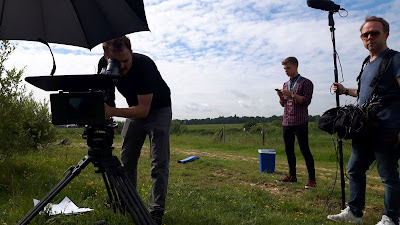There is an easy way to find them out though, as on a warm summer evening twitter feeds will light up with the phrases such as 'good haul!', and 'lifer!' or 'moth bonanza'! These are the moth recorders, and now and then, I join in to live life vicariously as a moth trapper.
Common Bird's-foot Trefoil and Meadow Vetchling, River Mole Grasslands
First off is some sweeping of the vegetation with nets, which turns up a few species which wont come to the light trap. I couldn't believe my luck with I spied this critter in the bottom of my net - an immaculate Six-belted Clearwing Moth (again something I have only ever seen before on other people's twitter feeds!)
Six-belted Clearwing (Bembecia ichneumoniformis)
Nationally Scarce B. A good mimic of a parasitic wasp
We are lucky to have Jake Everitt leading us; he is the warden at Warnham Local Nature Reserve and has been running moth traps at Gatwick for around 4 years now. It sounds like this was a pretty exceptional summer night along the River Mole, as together he and Laurie Jackson counted 448 of 98 different species.
Angle Shades (Phlogophora meticulosa) - a common but lovely moth
This excellent field guide is the ultimate companion for any mother. (Jake has another guide like this which is devoted specifically to the micromoths!)
Macromoth identification is very visual and doesn't often require a entomological key
(unlike the micromoths)
Blood-vein (Timandra comae) my personal favourite
Jake's highlights were the 13 Elephant Hawk-moths, 2 Southern Wainscott, the Dotted Fan-foot (a lifer for him) and Nephopterix angustella, which is a rare and distinctive little micro.
Elephant Hawk-moth (Deilephila elpenor) Another common species, the caterpillar
feeds on willowherbs, fuscias and Himalayan Balsam
Ecology student Connor with his new Elephant Hawk pal
A rather poor photo of a Dotted Fan-foot (Macrochilo cribrumalis)
(Nationally Scarce B)
I felt pretty guilty that I had to leave at midnight, as Laurie and Jake were still out emptying and packing up the traps after 1.30am! What an incredible time of year to be out though, often I don't even want to go home...


















